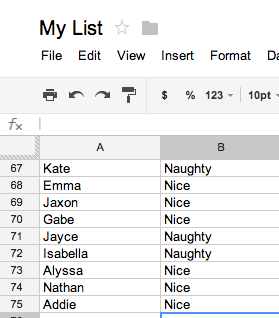
Metadata is one of those things that is so important, it becomes easy to forget about. We often collect metadata without thinking about it. When we don't collect it — or if we collect it in a sloppy manner — we notice very quickly that something has gone wrong. But when someone says the word "metadata", a large number of us go, "the what now?" And start trying to remember what that word means before we make ourselves sound dumb in conversation.
Metadata is really just information about information — it helps us organize, find, and standardize the things we know and want to know. At the Information Culture blog Bonnie Swoger offers some Christmas-themed examples that will help you remember what metadata is, help you understand why it's such a big deal, and improve your ability to do metadata right.
If you stumbled across this list on the web you might be able to guess what it was, but you couldn’t be sure. It would also be difficult to find this list again if you were looking for it. The list creator might find this pretty useful, but if he or she shared it with others, we would want some added information to help the new user understand what he or she was looking at: this is metadata.
Metadata for this data file:
Who created the data: Santa Claus, North Pole. An email address would be nice. This way we have some contact information in case we need clarification.
Title: “My List” isn’t a title that is conducive to finding the file again. While it might be tempting to just call this “Santa’s list” that won’t help other folks who see this file. The title should be descriptive of what the data file contains, and “Santa’s List” could be many things: Santa’s list of Reindeer? Santa’s list of toys that need to be made? A more descriptive title might be “Santa’s list of naughty and nice children.”
Date created: We don’t want to confuse this year’s list (2012) with last year’s list (2011). This could lead to all sorts of unfortunate events where nice kids get coal, naughty kids get presents, or infants (who weren’t around in 2011) get nothing at all.
Who created the data file: Perhaps Santa created the data, but then used an elf to input the data into a computer file. Many computer programs automatically record this information, although you may not realize this.
How the list was created: Behavioral scans? Parental surveys? Elf on the Shelf reports? All of the above? In order to reuse this data in future research projects, we need to know how it was collected, including collection instruments and methodologies.
Definitions of terms used: What is “naughty” what is “nice”? How did Santa place a child into one category or another?
File type: What kind of file is it? The data here are pretty simple, but Santa has lots of different file formats to choose from: excel, .csv, xml, etc. Knowing the file type helps end users determine if they can use the data.
Read the full story and get more great examples
No comments:
Post a Comment